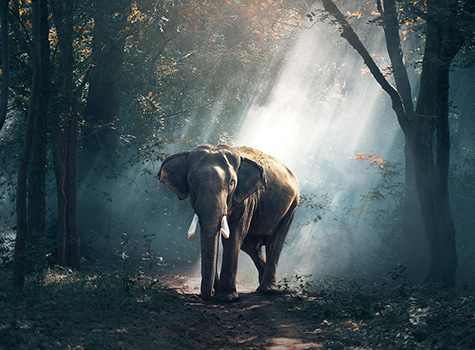By Jennifer Allen
March has come upon us once again with a sense of renewal as the long winter is shed and the lushness of spring is thrust upon us with healthy vegetation and vibrant colours everywhere. Many beliefs celebrate this rebirth and fertility in their own way… and one of the most well-known festivals (besides Easter) is the Hindu celebration of Holi. In fact, one could say that if there’s anything more “Indian” than the vivid shades of traditional South Asian clothing or mehndi tattoos, it has to be the layers of brightly hued powder that is a huge part of what makes Holi so memorable.
I’ve personally never taken part in a Holi celebration, but I’ve certainly seen presentations of it in various forms of media. Pictures of smiling people hugging while covered in multiple layers of rainbow dust. Watching young and old dance harmoniously together as they toss reds, blues, greens, and any other shade imaginable into the air with nothing but pure joy in their minds. It’s a party of epic proportions with a simple premise… to celebrate rebirth, forgiveness and love.
Originally coming from a Christian background, I first thought of how close Easter is to the traditions of Holi. The similarities are certainly there, for sure. A big part of Easter is that after 40 days of sacrifice and resistance to temptation (Lent), you can start anew with all past sins wiped away.
The story of Jesus on the cross and his apparent resurrection also leads to the thought of forgiveness for past indiscretions. Instead of colourful powder thrown around, there are radiantly decorated eggs that are hidden for children to find and enjoy along with other tasty treats.
However, since my college days and my expanded education of many other religions and beliefs in the world, I actually find Holi much more closely related to the lesser known Celtic celebration of Beltane. In fact the comparisons between the traditions of Holi and Beltane are quite intriguing despite being separated by almost 8,000 kilometers and the two cultures not even meeting until the Portuguese formally introduced India to Europe around 1500 CE. While Holi is often celebrated on the last full moon before the spring equinox, Beltane is observed on the full moon in-between the spring equinox and summer solstice.
Beltane came about as a Celtic tradition mostly in Ireland and Scotland as a festivity of fertility and for the protection of crops and livestock. More commonly known as May Day outside of Pagan circles, Beltane itself had almost completely died out until resurgence in the 1990’s by Neopagans and modern Wiccans brought it back into the fold as a practice.
Taking both festivals into account and list the traditions in each, you could just about make them interchangeable. More so, there’s always something magical about being around likeminded individuals who share in so much positive energy. You forget that the person next to you is young or old or if they have dark or light skin. You are simply sharing a moment in time where everyone is celebrating something as precious as being alive and leaving behind any past concerns.
To start with, both begin with a ritual bonfire. For Holi it is a symbol for burning away evil and leaving only the good behind. For Beltane it is a means of protection from harm and a way to encourage optimism. No matter what heritage you come from, fire has been shown to be a symbol of metamorphosis; destruction and renewal. It can keep us warm and offer us a light in the darkness, but if used improperly it can consume everything in its path. Both beliefs understand this duality and use the flame as a first step towards a better future.
After the initial burning away of the past, there is a gala of boisterous dancing, singing and feasting. Both celebrate the arrival of spring and the beauty of birth. While Holi is often depicted as a festival of love, Beltane is also often cited as a celebration of fertility. Granted, in modern times it can be seen not only as a blessing for children but also as an invocation of creative inspiration. I think Holi is a representation of a more chaste type of love between Krishna and Radha, but still a very important aspect of it.
And then there is the grand display of colours in both, which are no doubt inspired by the splendid hues of spring flowers. Holi has the aforementioned powder aspect, while Beltane has several elements involved. The first is the collection of yellow flowers that are picked by children and placed in doorways in bouquets or wreathes. Secondly there is a tradition of dancing around the Mayday pole with bright flowers and either ribbons or vines. Dancers will weave the ribbons/vines around the pole clockwise (to follow the sun’s path from east to west) as a blessing of good luck and virility. Often during the dancing, Beltane participants will also paint themselves in bright shades of red, blue or green and otherwise will (often) be minimally clothed.
The changing of seasons influences many people’s lives no matter which part of the world they live in, so it’s no surprise that both cultures have mirrored festivals such as Holi and Beltane. Maintaining a bountiful harvest and protecting livestock are some of the most basic parts of survival, and appreciating these accomplishments with a mixture of dance, song and colour is frankly just a whole lot of fun.
I do plan to participate in both festivals this year to more properly experience what both have to offer. In fact, I think we can learn a lot about human nature in general from both since they personify the regenerative of facets of spring and a chance to start again. Most importantly, they teach us that we can simply be together and celebrate without judgement or preconception.
Perhaps with just a little dash of colour and a big dash of hope, we can all forgive and simply be.



